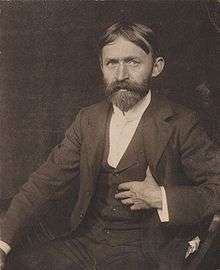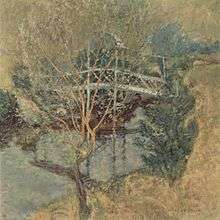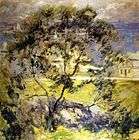John Henry Twachtman
| John Henry Twachtman | |
|---|---|
 Twachtman, c. 1900. Photo by Gertrude Käsebier | |
| Born |
August 4, 1853 Cincinnati, Ohio |
| Died |
August 8, 1902 (aged 49) Gloucester, Massachusetts |
| Nationality | American |
| Education | Frank Duveneck, Academy of Fine Arts, Munich |
| Known for | Impressionism, Landscape art |
John Henry Twachtman (August 4, 1853 – August 8, 1902) was an American painter best known for his impressionist landscapes, though his painting style varied widely through his career. Art historians consider Twachtman's style of American Impressionism to be among the more personal and experimental of his generation. He was a member of "The Ten", a loosely allied group of American artists dissatisfied with professional art organizations, who banded together in 1898 to exhibit their works as a stylistically unified group.
Studies

Twachtman was born in Cincinnati, Ohio and received his first art training there under Frank Duveneck.[1] Like most artists of the era, Twachtman then proceeded to Europe to further his education. He studied at the Academy of Fine Arts in Munich from 1875 to 1877,[1] and visited Venice with Duveneck and William Merritt Chase. His landscapes from this time exhibit the loosely brushed, shadowy technique taught at Munich. Twachtman also learned etching, and sometimes carried etching plates with him that he could use to spontaneously record a scene.
After a brief return to America, Twachtman studied from 1883 to 1885 at the Académie Julian in Paris, and his paintings dramatically shifted towards a soft, gray and green tonalist style. During this time he painted what some art historians consider to be his greatest masterpieces, including Arques-la-Bataille, in the collection of the Metropolitan Museum of Art in New York, and Springtime, in the collection of the Cincinnati Art Museum.
Maturity
 Landscape, Branchville, c. 1888, 152.4 × 203.2 cm.
Landscape, Branchville, c. 1888, 152.4 × 203.2 cm. Wild Cherry Tree, oil on canvas, c. 1901. Albright-Knox Art Gallery
Wild Cherry Tree, oil on canvas, c. 1901. Albright-Knox Art Gallery Fishing Boats at Gloucester, 1901. Smithsonian Museum of American Art
Fishing Boats at Gloucester, 1901. Smithsonian Museum of American Art
In 1886, he returned to America and settled in Connecticut, eventually buying a farm in Greenwich. He often painted and exhibited with fellow artist Julian Alden Weir, and spent considerable time at the art colony in Cos Cob. His presence was vital to the colony:
"Twachtman's temperament--by turns gregarious and introspective, restless and serene--was a major factor in preventing the Cos Cob art colony from becoming a backwater of nostalgic complacency. Ironically, his lack of commercial success contributed to his artistic independence, freeing him from the temptation of producing salable pictures according to a proven formula. His art, conversation, and teaching fueled the creative fires of his friends and students in Cos Cob." [2]
In addition to his oil paintings, Twachtman continued to create etchings as well as drawings in pastel. Twachtman taught painting at the Art Students League from 1889 until his death in 1902. Twachtman was close friends with Julian Alden Weir and the two often painted together and both also had close associations with the Danish-born painter Emil Carlsen. In 1893, Twachtman received a silver medal in painting at the Columbian Exposition; the same year, he also exhibited his work with Claude Monet at a New York gallery.[1]
In Connecticut his painting style shifted again, this time to a highly personal impressionist technique. Twachtman painted many landscapes of his farm and garden in Greenwich, often depicting the snow-covered landscape. He executed dozens of paintings of a small waterfall on his property, capturing the scene in different seasons and times of day. Late in life Twachtman visited Gloucester, Massachusetts, another center of artistic activity in the late 19th century, and produced a series of vibrant scenes that anticipated a more modernist style yet to gain prominence in American art.
Twachtman died suddenly in Gloucester of a brain aneurysm, aged 49.[3] Today, his works are in many museum collections including the Metropolitan Museum of Art, New York; the National Gallery of Art, Washington, D.C.; and the Museum of Fine Arts, Boston. Among his pupils were the painter Katherine Langhorne Adams[4] and the painter and pastellist Annie E. A. Walker.[5] he was also a major influence on painter Louise Zaring, who had worked with him in Indiana early in her career.[6] The painter Ernest Lawson studied with Twachtman at the Art Students League in New York and at the Cos Cob, Connecticut, art colony. [7]
See also
References
- 1 2 3 Roberts, Norma J., ed. (1988), The American Collections, Columbus Museum of Art, p. 30, ISBN 0-8109-1811-0 .
- ↑ Larkin, Susan G., The Cos Cob Art Colony, p. 5. Yale University Press, 2001.
- ↑ Peters, Lisa N. (2006), John Twachtman: A Painter's Painter, Spanierman Gallery, LLC, p. 244 .
- ↑ EHRMANN, Thierry. "Katherine Langhorne ADAMS (1890-1977) : Auction sales, auction prices, indices and biography of Katherine Langhorne ADAMS - Artprice.com". www.artprice.com. Retrieved 30 December 2017.
- ↑ "WALKER, Annie E.A. (1855–1929), Painter, pastellist : Benezit Dictionary of Artists – oi". doi:10.1093/benz/9780199773787.article.b00204462. Retrieved 24 January 2017.
- ↑ "Louise Zaring – Artist, Fine Art Prices, Auction Records for Louise Zaring". Retrieved 1 May 2017.
- ↑ "American Impressionism and Realism: The Painting of Modern Life, 1885–1915". The Metropolitan Museum of Art, New York. Retrieved 7 Sep 2017.
Further reading
- Gerdts, William H. (2001). American Impressionism (Second ed.). New York: Abbeville Press Publishers. ISBN 0-7892-0737-0.
- Larkin, Susan G. (2001). The Cos Cob Art Colony. New York: the National Academy of Design. ISBN 0-300-08852-3.
- Peters, Lisa N. (1999). John Henry Twachtman : An American Impressionist. Atlanta, Georgia: Hudson Hills Press. ISBN 1-55595-178-3.
- Peters, Lisa N. "John Twachtman (1853–1902): A 'Painter's Painter,'" Spanierman Gallery, 2006 ISBN 0-945936-77-X
External links
| Wikimedia Commons has media related to John Henry Twachtman. |
| Wikisource has the text of a 1921 Collier's Encyclopedia article about John Henry Twachtman. |
- www.johnhenrytwachtman.org 243 Works
- Biography and works, Cincinnati Art Museum
- John Henry Twachtman at Find a Grave
- John H. Twachtman Catalogue Raisonné
- UNCG American Publishers' Trade Bindings: John Henry Twachtman
- American impressionism and realism : a landmark exhibition from the Met, a 1991 exhibition catalog from the Metropolitan Museum of Art libraries
